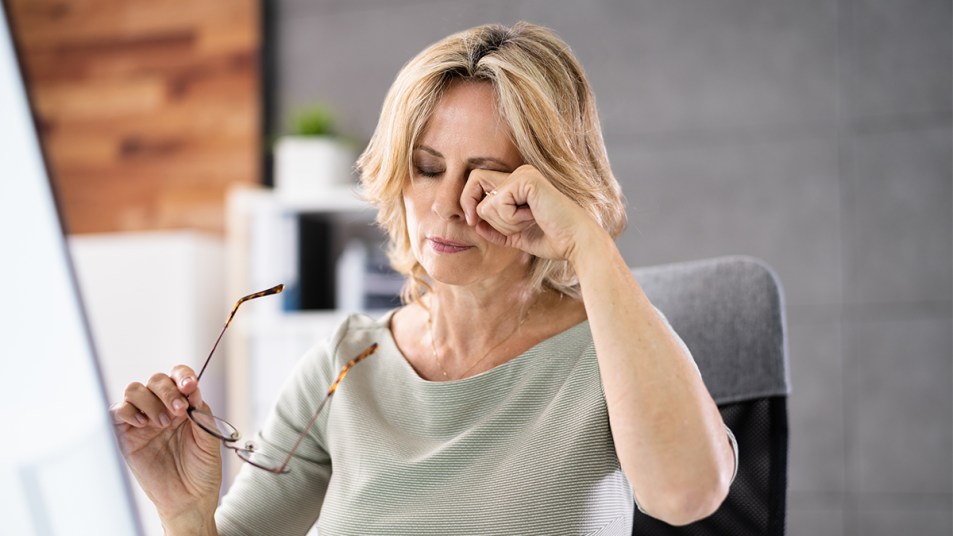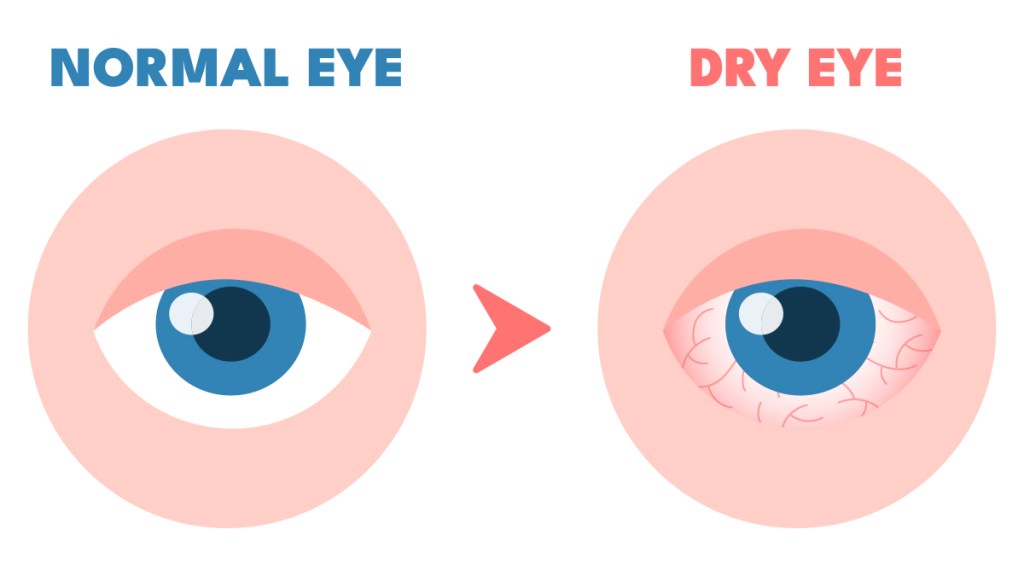The Berry Extract Doctors Recommend to Relieve Dry Eye More Safely Than Eye Drops
Up to 79% of women over 40 will suffer from dry eye — and the tiredness that can come with it!

On November 3rd, the FDA updated its warning consumers to immediately stop using 28 over-the-counter eye drop products due to the potential risk of eye infections that could result in partial vision loss or blindness. The over-the-counter lubricating drops are sold by CVS, Rite Aid, Target, Walmart, Leader, Rugby and Velocity Pharma and are intended to help moisturize dry eyes. Click through to the complete list here. Contaminated eye drops are of special concern because the bacteria can travel directly through the tear ducts to your nasal passages. This is the latest in a series of eye drop recalls, and it begs the question: wouldn’t it be great if you could relieve the symptoms of dry eyes without the risk of dropping something in your eye? That way you’d have your gut to protect you from potential contamination. The good news: Growing research suggests is a Peruvian superfruit known as maqui berry — a simple, inexpensive, extract that you take as supplement — provides significant relief from dry eye. Read on for more details from doctors on dry eye and maqui berry, plus how it helped one woman overcome dry eye and the overwhelming fatigue it caused.
What is dry eye?

Dry eye occurs due to a deficit of tears, which are made up of three layers: a mucin layer that distributes tear film across the surface of the eye, an aqueous layer that’s mostly water and an oily lipid layer that keeps tears from evaporating. Without enough of these tears, eyes literally dry out.
There are two causes of dry eye that accord with problems producing two of the layers of tears. In the first instance, lacrimal glands, which produce the watery layer, can malfunction to trigger aqueous dry eye. In the second case, dysfunction of meibomian glands that produce the lipid layer can cause tears to evaporate faster than usual, resulting in evaporative dry eye, the most common form of dry eye. Research shows that 30% of dry eye patients suffered from mixed dry eye, a combination of aqueous and evaporative types.
What makes dry eye so draining
Not only does dry eye make simple visual tasks (like reading, using the computer and knitting) difficult, studies reveal that all that straining to see can leave you feeling tired, amp up feelings of frustration and embarrassment and interfere with work life, personal relationships and the ability to participate in social and leisure activities. One study even found an association between dry eye and developing chronic fatigue syndrome (DFS).
It’s no secret that dryness triggers eye redness and irritation. But dry eye can deplete energy, too. “The symptoms of dry eye affect not just comfort levels but vision, which places strain on the eyes, making it more challenging to get through the day,” explains Diane Hilal-Campo, MD, an ophthalmologist in Oakland, New Jersey. And according to Robert Latkany, MD, author of The Dry Eye Remedy, the stress of coping with dry eye irritation can make even mild cases exhausting.
4 reasons dry eye is all too common
Dry eye impacts an estimated 50 million Americans, according to a study in the journal Opthalmology and Therapy. But other research suggests dry eye incidence is much higher: A report in JAMA Opthalmology found 73% of people who experienced symptoms were undiagnosed. And some surprisingly common factors can increase the risk of experiencing dry eye:
1. Eye lubrication diminishes over time
“Dry eye becomes more common with age,” says ophthalmologist Steven Maskin, M.D. Scientists reporting in the journal International Ophthalmology Clinics explain the number of goblet cells that produce cornea-protecting mucin drops over time. Plus, lacrimal and meibomian glands become atrophied and produce less lubricating fluids. The result: In a Harvard University study, risk of dry eye proved 95% higher in folks aged 45 to 54 compared to their younger counterparts.
2. Hormonal changes decrease tear production
“Just about every woman will suffer from dry eye at some point,” says Dr. Latkany. In a Harvard University study dry eye was 2 to 3 times more common in women compared to men. Blame it on hormones, says Ann Louise Gittleman, PhD, author of Radical Longevity, who notes that hormonal fluctuations due to menstruation and perimenopause impair tear production.
Indeed, experts reporting in Clinical and Experimental Optometry point out that increases in estrogen and progesterone suppress activity of tear-producing glands. And while these hormones drop during menopause, so do hormones known as androgens. The reason that’s a problem: “Androgens are necessary for proper function of the meibomian glands that produce the lipid layer,” says ophthalmologist David R. Hardten, M.D. “But hormone fluctuations can disrupt gland functioning, resulting in dryness.” The proof? A study published in the journal Climactric found 79% of perimenopausal and postmenopausal women experienced dry eye symptoms.
3. Digital devices leave eyes parched
When it comes to your eyes, computers and smartphones are major moisture-sappers. In fact, a study in the journal Risk Management and Healthcare Policy deemed excessive use of electronic devices a leading trigger of dry eye. Turns out we typically blink 22 times per minute, which stimulates tear glands and sweeps tear film over eyes. But we only blink 7 times per minute when staring at digital screens, which leaves eyes deprived of lubricating fluids.
4. Medical conditions can dry out eyes
Dry eye is a hallmark of a condition known as Sjogren’s syndrome. Experts have long known that the syndrome causes the immune system to mistakenly attack lacrimal glands, lowering their fluid output. But as authors of a recent study in Ophthalmology Therapy note, Sjogren’s can also damage and destroy oil-producing meibomian glands.
The high blood sugar levels that mark diabetes can also damage nerves in the eye to lower tear production. In a study published in the journal Cureus, investigators found 52% of patients with diabetes also suffered from dry eye.
What’s more, irritable bowel diseases (IBD) such as Crohn’s and ulcerative colitis can damage the intestines so contents leak into tissues, triggering inflammation that causes tear production to falter, say authors of study published in BMC Ophthalmology, who determined IBD increased dry eye risk by 43%.
Also of note: dry eye is 95% more common in people with thyroid conditions than people without, according to a study in the Journal of Clinical medicine. “Normal thyroid hormone levels are essential for the production of healthy tears,” explains Dr. Maskin.
How to tell if dry eye is draining your energy
Doctors can diagnose dry eye with painless tests such as a Schirmer’s test that determines whether you’re producing sufficient tears, and a tear break up time (TBUT) test that measures how long tear film remains over your eyes after blinking. But if you experience the following red-flag symptoms, dry eye could be the culprit:
- Fatigue
- Red, irritated, gritty eyes
- Blurry vision
- Eye itching
- Sensitivity to light
- Excessive tearing
- Blue moods
- Anxiety
- Headaches
How maqui berry eases dryness

A superfruit that’s native to Chile, maqui berry is loaded with antioxidants. That’s key, since antioxidants protect against an eye-drying process known as oxidative stress. In fact, findings in the journal Latin American Nutrition Archives reveal maqui berries have an antioxidant action that’s 297% higher than strawberries and 247% higher than blackberries. And according to Gittleman, the extract of maqui berry can refresh dry eyes in as little as 30 days.
Research bears out the benefits: Researchers in the Journal of Traditional and Complementary Medicine found taking 60 mg of maqui extract daily slashed dry eye symptoms by 57% while increasing tear production by 89% within 4 weeks.
And a study published in the Indian Journal of Ophthalmology found that maqui berry spurred significant improvements in tear production and slashed the distress of dealing with dry eye symptoms by 80% in 4 weeks. One to try: Life Extension Tear Support with MacquiBright (Buy at LifeExtension.com, $10.80 for 30 capsules).
Related: Maqui Berry Extract Is a “Million Times More Powerful Than Taking Vitamin C”
4 other simple steps to relieve dry eye naturally
1. Tuck into tuna salad
In a study conducted at Harvard University, dry eye risk was 68% lower in women who enjoyed 3 servings of tuna weekly compared to their counterparts who never ate tuna. Why? Tuna is rich in friendly fatty acids known as omega-3s. “Omega-3s nourish the outer, oily layer of tear film that slows evaporation,” says optometrist Justin Bazan, O.D.. “Plus, they soothe inflamed tear glands.” He advises eating omega-3–rich tuna, salmon, sardines or herring three times per week. (Click through for more on how the right mix of omega 3, 6 and 9s speeds weight loss.)
2. Do this when using digital devices

“Blinking spreads tears over the front of our eyes to keep them moist,” says Sacramento, California, optometrist Heidi Pham-Murphy, OD. “When we don’t blink enough our eyes dry out and feel irritated.” Her advice: Pause every 20 minutes to look 20 feet away for 20 seconds — and blink! Also smart: adjusting the angle of your computer screen. “Looking up at the computer screen widens the palpebral fissure — the distance between the upper and lower eyelids — exposing more of the eyes’ surface to evaporation,” explains Jeffrey Weaver, OD. To avoid this, lower the monitor (or raise your seat) so you’re looking slightly downward at the center of the screen to conserve moisture in the eyes.
3. Take a breath break
Deep breathing boosts tear production by 52% within 15 minutes, according to a study published in the journal Ocular Surface. Investigators found the benefits in participants who did 3 minutes of abdominal breathing, and explain the technique activates the parasympathetic nervous system. That’s key, since the parasympathetic nervous system sends stimulating signals to lacrimal that produce the watery layer of tears. To get the benefits, inhale slowly and deeply through your nose for 4 seconds, then exhale through your mouth for 6 seconds. Repeat the cycle for a total of 3 minutes. (Click through to learn how regulating your nervous system can ease stress.)
4. ‘Wash’ your eyes three times weekly
“Make cleaning your eyes a regular part of your personal-care routine,” urges Dr. Latkany. Doing so prevents the clogging of the eyelids’ meibomian glands, which produce secretions that keep eyes lubricated. The regimen he advises doing three times a week: Place a warm moistened towel over your eyes for 3 minutes to loosen debris that’s plugging up glands. Using the tip of your finger, gently massage along the edges of the upper and lower margins of your eyelids to push the contents of the meibomian glands up and out of the ducts.
Splash cool water into your eyes to wash off the gunk you’ve loosened, then apply chilled preservative-free drops to each eye.
Dry eye success story: Tracey Poten, 51

“Sorry guys, I’m going to bed,” Tracy Poten told her family, grimacing at the disappointed looks she got from them as she canceled yet another family movie night. “Once again, physical and mental exhaustion caused by my dry, burning, itchy eyes forced me to avoid electronic devices,” Tracy recalls. “I went upstairs to try to recharge my batteries by going to bed early, because dry eye made it difficult to get a good night’s sleep.”
Tracy felt like she was in a ‘lose-lose’ situation
“As a 911 operator, I spent hours at a time with my eyes fixed on multiple computer screens, which my eye doctor explained can lead to developing dry eyes because all that screen time decreases the number of eye blinks, leading to incomplete blinking, evaporation of tears and, ultimately, dry eye disease. I tried to remember to blink more often, but that was nearly impossible due to the demands of work and the unnatural feeling of telling yourself to blink.
“My allergies to grass, trees and other environmental triggers made things worse because the antihistamines that best treated those symptoms also further dried out my eyes. I was forced to either sneeze and sniffle all day long and lie awake at night with allergy postnasal drip and other symptoms, or treat my allergies and increase the irritating feeling in my eyes. But that also disrupted my sleep because I was frequently waking up during the night with my eyes stuck together. This is a lose-lose, I often told myself, feeling frustrated and exhausted.
“I cycled through a variety of over-the-counter products, including allergy medications and eye drops, with no long-term relief, as my dry eyes worsened. I tried forgoing my allergy medicines, but that only made me more tired during the day because I’d lie awake all night battling allergy symptoms.
“Whenever I was in a warm or dry environment, my eyes felt especially irritated, making the fall and winter months, when the heat is on, miserable. And because the room I spend most of my time in at work is very dry, and the screens and devices we use throw off both heat and blue light, the job that I love makes my eyes feel worse.
“The strain of spending hours looking at a screen at work made my eyes feel so strained and tired, which took a toll on me. At the end of my shift, I was usually exhausted, and I couldn’t wait to lie down and rest to try and restore my strength the second I walked in the door at home.
“Every morning, I’d drag myself to the bathroom to use various remedies, including expensive prescription eye drops that didn’t provide any more relief than much less expensive over-the-counter drops. But nothing worked, and along with always being red and feeling scratchy, my eyes always felt tired, and that only made me feel more frustrated—and zapped my energy.
How Tracy discovered maqui berry for dry eye
“I was trapped in a dizzying cycle of feeling both mentally and physically exhausted, and I wasn’t sure what to do about it. One day, a friend mentioned she had tried a supplement called Total Eye Health + Blue Light Filter (Buy at LightBodyLabs, $40 for a one-month supply) for her dry eyes and to help improve her vision from excessive screen and device time due to her job.
“When I researched the supplements, I read that one of the key ingredients is maqui berry. I read that antioxidants — such as those found in maqui berry—can offer protection against light-induced damage, and studies found that maqui berry extract prevented light-induced damage in eye cells, suggesting that the fruit may be beneficial for eye health. What do I have to lose? I thought and ordered them.
Today, Tracey has her life back
“I started taking one capsule every evening after dinner and noticed small changes within a few weeks. My vision was clearer and not as foggy as before using the supplements and I wasn’t using my eye drops as often. Best of all, I was able to sleep soundly all night, no longer waking up with dry, crusty eyes that I had to gently pry open.
“After a month or so, my eyes felt healthy, and my energy was restored. I’m so happy to finally be able to wear my contacts again, work with confidence and sleep soundly. I had no idea a supplement could give me back my life!
This content is not a substitute for professional medical advice or diagnosis. Always consult your physician before pursuing any treatment plan.
For more healthy eye information, keep reading
Marigold Extract is ‘Supreme’ for Improved Eyesight, Says Top Eye Doc
Opthalmologist: These Nutrients Can Protect Your Sight From Macular Degeneration













